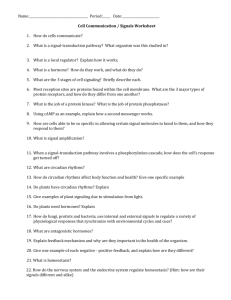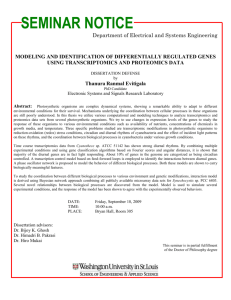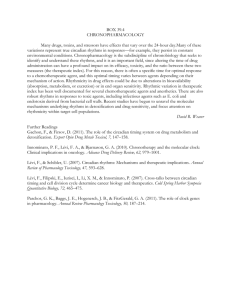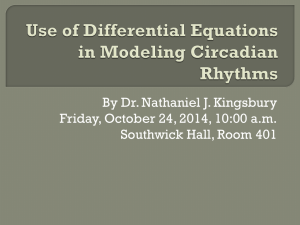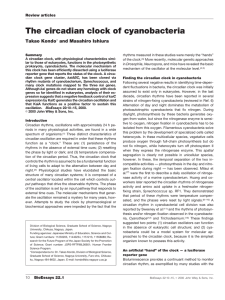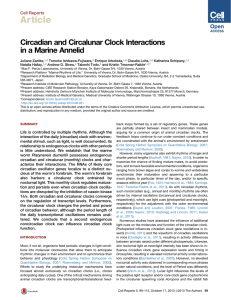molekulové základy chronobiologie čas v živých organismech
advertisement
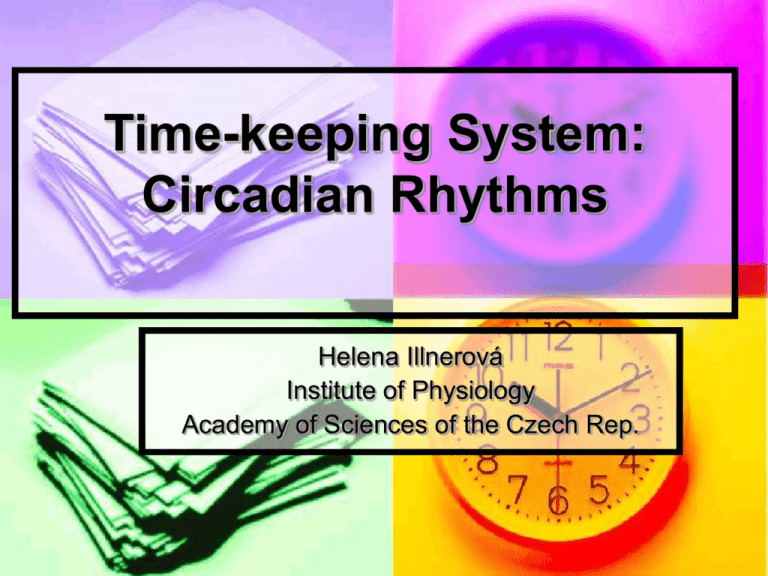
Time-keeping System: Circadian Rhythms Helena Illnerová Institute of Physiology Academy of Sciences of the Czech Rep. CIRCADIAN RHYTHMS sleep-wake cycle body temperature behaviour food and water intake hormones metabolism body fluids expression of genes Subjective night Evening: sleepiness increases melatonin increases body temperature decreases Morning: cortisol increases melatonin decreases body temperature increases The subjective night is not necessarily equal to the real night The outside period T = 24 h Entrainment: Tau* = 24 h Tau > 24 h: daily phase advance is necessary Tau < 24 h : daily phase delay is necessary Light Entrainment • Light in the evening and in the first half of the night delays phase of the rhythms. • Light in the second half of the night and in the morning advances phase of the rhythms • Light during the subjective day does not change phase of the rhythms THE PINEAL GLAND: SEROTONIN N-ACETYLTRANSFERASE N-ACETYLSEROTONIN HYDROXYINDOL-O-METHYL TRANSFERASE MELATONIN DAY 0 DAY 1 TIME (h) THE MAMMALIAN CLOCK GENES Clock BMal 1 (Mop 3), BMal 2 Per 1, Per 2 (Period) Cry 1, Cry 2 (Cryptochrome) Rev – Erb α CK1 Є CK1 δ (kasein kinase) CLOCK-CONTROLLED GENES Per 3 AVP (arginin vasopresin) Dbp (D-element binding protein) translation Per mRNA) protein product of the clock transcription modification ? DNA (gene Per) modified protein of the clock Protein transfer to the nucleus + ++ +++ - DNA - - DNA - - DNA – + ++ +++ Clock-controlled genes Overt circadian rhythms Are the clock genes responsible for CHRONOTYPES? Larks vs. owls? Vision entrainment PHOTORECEPTORS retinal rods and cones retinal ganglionic cells PHOTOPIGMENT Rodopsin Melanopsin Optic nerves RHT, GHT Optic cortex SCN; ? First, second and third messengers GLUTAMATE cAMP; cGMP; Ca ions; NO C-FOS; pCREB; PER1; PER2 Hierarchy of the Circadian System SCN Light Melatonin NPY liver lungs kidney heart Restricted feeding Glucocorticoids pancreas ENTRAINMENT OF THE TIME-KEEPING SYSTEM - Entainment of the SCN: by light Entrainment of peripheral organs: From SCN By feeding Via corticoids ? Peripheral organs as clocks - Oscillation in the organ culture - Different periods and phases - Oscillations persist even after the SCN lesion but become desynchronized - PERIPHERAL ORGANS ARE CLOCKS PER SE BUT SCN PLAYS THE COORDINATION AND SYNCHRONIZING ROLE Expression of Genes - - About 10% of genes are expressed in a rhythmic way: CLOCK GENES CELL CYCLE GENES GENES FOR APOPTOSIS ORGAN SPECIFIC GENES Partial hepatectomy Go Clocks of the cell cycle G1 M Circadian clocks BMAL 1 CLOCK CDC 25 hourglass CDC 2 CYCLIN B S Liver growth G2 REV-ERBQ WEE 1 CRY 1, 2 PER 1, 2 TUMOUR GROWTH • PER2 Bmal1/Clock c Myc • PER2 p53 apoptosis • A WEAK CIRCADIAN SYSTEM - - METABOLIC DISORDERSOBESITY In food intake (night eating syndrom) In balance of rhythms of leptin, ghrelin, insulin (e.g., when sleep is insufficient ) In loss of appetite (Clock mutant mice) Disorders of the Circadian System Free-run DSPS ASPS Fragmentation of sleep Higher risk for oncologic diseases Metabolic disorders CHRONOBIOLOGY Molecular Biology Neurobiology Ethology Internal Medicine Sports and Labour Medicine Psychology Psychiatry Neurology The wonder of the world, the beauty and the power, the shapes of things, their colour, lights and shades. These I saw. Look ye also while life lasts.
